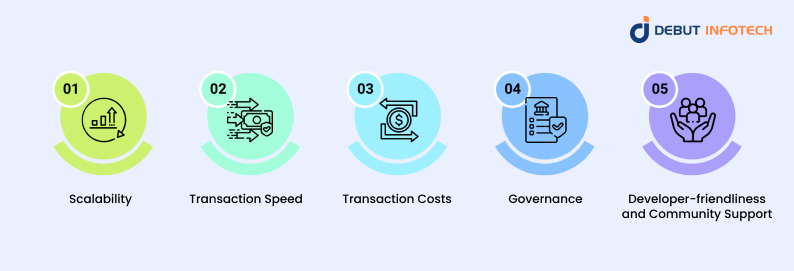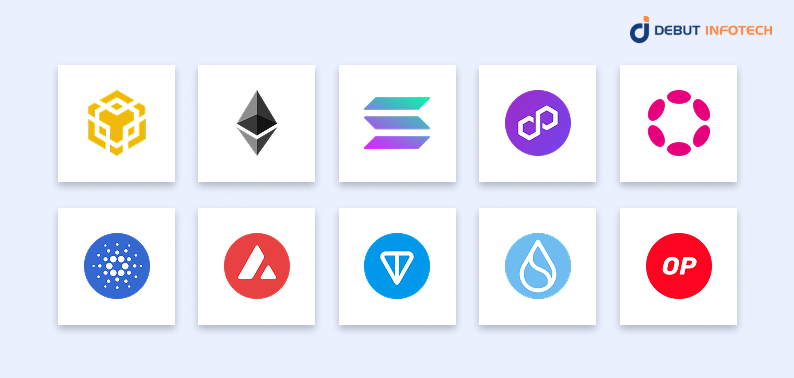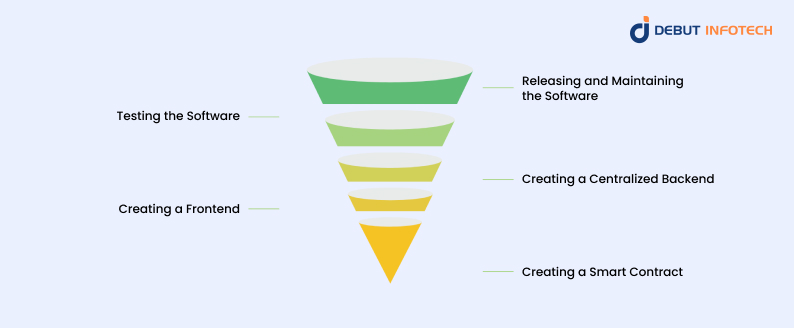Table of Contents
Home / Blog / Blockchain
A Complete Guide to Blockchain dApps & Their Key Benefits
April 3, 2025

April 3, 2025
Blockchain decentralized applications (dApps) are transforming digital interactions by removing intermediaries and promoting transparency, security, and user autonomy. In contrast to traditional applications, dApps operate on decentralized networks, utilizing smart contracts to execute transactions without centralized oversight. Their influence spans various industries, including finance, gaming, governance, and social media, providing users with trustless and tamper-proof systems.
The dApp market has grown substantially, with over 6,000 dApps deployed across multiple blockchains as of 2024. Additionally, the decentralized finance (DeFi) sector has seen a significant surge, with the total value locked (TVL) reaching approximately $192 billion in May 2024, marking the highest level since February 2022.
Leading networks such as Ethereum 2.0, Solana, and Binance Smart Chain are at the forefront of this expansion, offering developers a diverse range of platforms tailored to various application needs.
As dApp development continues to accelerate, selecting the best blockchain for dapps becomes crucial. This article will discuss how blockchain dApps work, their benefits, and key considerations for blockchain selection. We will also shed light on the top blockchain to build dapps in 2025, real-world applications, the development process, and the future trajectory of dApps technology.
What are Blockchain dApps?
Decentralized applications (dApps) are software applications built on a blockchain network, not a central server. DApps provide the same kind of security and trust that users expect from traditional applications. But, they are deployed instead using smart contracts that are permanent and impervious to tampering. These applications don’t rely on third parties, providing users with a more decentralized and trustless experience.
How Do Blockchain dApps Work?
Decentralized applications use blockchain technology to perform actions through smart contracts—self-executing agreements written in code. Users interact with dApps via a frontend interface, while the backend logic is stored on a decentralized network. Transactions within a dApp are recorded on a blockchain, ensuring data integrity and security. Additionally, dApps often use cryptocurrencies or tokens for payments, governance, and incentives.
Understanding Blockchain dApp Development
Developing a blockchain dApp involves multiple components, including choosing the right blockchain, coding smart contracts, designing a user interface, and ensuring scalability. Developers must also address security concerns, as vulnerabilities in smart contracts can lead to significant risks. With the right enterprise blockchain development approach, dApps can revolutionize industries by enhancing efficiency, security, and accessibility.
Perks of Blockchain dApp Development
1. Decentralization
Unlike traditional applications that rely on centralized servers, dApps operate on blockchain networks, eliminating single points of failure. This enhances security, prevents unauthorized control, and ensures continuous availability. Users retain greater autonomy over their data and transactions, reducing reliance on third parties and mitigating risks of censorship or manipulation.
2. Enhanced Security
Blockchain technology secures dApps through cryptographic encryption and immutable records. Transactions are stored on a distributed ledger, making unauthorized alterations nearly impossible. Additionally, smart contracts enforce predefined rules, reducing fraud and cyber threats. This security framework is valuable for financial services, identity verification, and confidential data management applications.
3. Trustless Transactions
Smart contracts automate user agreements, eliminating the need for intermediaries such as banks or payment processors. This fosters a transparent and trustless ecosystem where transactions execute automatically when predefined conditions are met. Users gain confidence knowing that the system operates fairly, reducing disputes and ensuring reliability.
4. Global Accessibility
Since dApps run on decentralized networks, they can be accessed from anywhere in the world without geographical restrictions. This makes financial services, gaming platforms, and social applications more inclusive. People in regions with limited banking infrastructure can participate in the digital economy without requiring traditional financial institutions.
5. Reduced Costs
By cutting out intermediaries, dApps significantly lower operational and transaction costs. Businesses and users benefit from faster and cheaper transactions, especially in industries such as finance, supply chain management, and remittances. Lower fees encourage higher adoption, making dApps a cost-effective alternative to traditional centralized platforms.
6. Monetization Options
Blockchain dApps provide multiple revenue-generation opportunities, including transaction fees, premium features, token sales, and advertising. A top-tier blockchain development company or experienced developer can also implement staking mechanisms, decentralized finance (DeFi) services, or non-fungible token (NFT) marketplaces to generate sustainable income. This flexibility allows businesses and individual creators to build profitable blockchain-based applications.
Key Considerations for Choosing a Blockchain for dApp Development

Here are some factors to consider when choosing the top blockchain to build dapps:
1. Scalability
A blockchain’s ability to handle increased transaction volumes is crucial for dApp efficiency. High scalability ensures that the network can support growing user demand without congestion or slowdowns. Blockchains with advanced scaling solutions, such as sharding or layer-2 protocols, offer improved performance, making them ideal for large-scale applications.
2. Transaction Speed
Fast transaction processing enhances user experience by reducing wait times and ensuring seamless interactions. Blockchains with high throughput enable real-time operations, which is essential for applications like gaming, finance, and supply chains. Networks employing optimizations like parallel processing or consensus improvements can achieve near-instant transaction finality, improving overall efficiency.
3. Transaction Costs
High transaction fees can discourage users and limit adoption. Choosing a blockchain with low and predictable costs ensures affordability, especially for high-volume dApps. Layer-2 solutions, fee optimization mechanisms, and alternative consensus models help keep costs manageable while maintaining security, making blockchain-based applications more accessible to a wider audience.
4. Governance
A blockchain’s governance model affects decision-making, protocol upgrades, and long-term sustainability. Some networks use decentralized autonomous organizations (DAOs) to allow community participation, while others have centralized structures. Understanding governance mechanisms helps blockchain consultants and developers choose blockchains that align with their needs, ensuring adaptability and transparency in future development and policy changes.
5. Developer-friendliness and Community Support
A strong developer community, comprehensive documentation, and accessible development tools simplify dApp creation and maintenance. Blockchains that provide extensive software development kits (SDKs), robust APIs, and active forums enable faster problem-solving and innovation. A well-supported ecosystem fosters collaboration, ensuring continuous improvements and long-term project sustainability.
Real-World Impact: Common dApp Use Cases
1. DeFi (Decentralized Finance)
DeFi dApps eliminate intermediaries in financial services, enabling users to lend, borrow, trade, and earn interest directly through smart contracts. Platforms like decentralized exchanges (DEXs) and liquidity pools provide transparent, permissionless access to global finance, reducing costs and enhancing security while promoting financial inclusion for unbanked populations worldwide.
2. NFTs (Non-Fungible Tokens)
NFT-based dApps allow users to buy, sell, and trade unique digital assets such as art, music, and virtual collectibles. Blockchain ensures authenticity and ownership verification, preventing counterfeiting. Artists and creators benefit from royalties through smart contracts. At the same time, industries like gaming and entertainment integrate NFTs for digital asset monetization.
3. Supply Chain Management
Blockchain-based supply chain dApps enhance transparency and efficiency by recording product movements on an immutable ledger. Businesses can track goods in real time, reducing fraud, counterfeiting, and delays. Automated smart contracts streamline payments and logistics, ensuring trust among suppliers, manufacturers, and consumers while improving overall operational accuracy.
4. Gaming
Blockchain gaming dApps introduce play-to-earn models where players can securely own and trade in-game assets. Items like characters, weapons, and virtual land are tokenized as NFTs, allowing real-world value exchange. Decentralized game economies empower players, reduce fraud, and provide developers with innovative monetization strategies beyond traditional gaming revenue models.
5. Governance
Decentralized Autonomous Organizations (DAOs) use governance dApps to enable transparent decision-making processes. Token holders vote on proposals, ensuring collective participation in managing decentralized networks or projects. This approach eliminates centralized control, making governance more equitable and community-driven while fostering accountability and innovation within blockchain ecosystems.
6. Social Media
Decentralized social media dApps offer censorship-resistant communication and fair content monetization. Unlike traditional platforms, users retain control over their data, and blockchain-based rewards incentivize engagement. These blockchain platforms prevent manipulation by centralized entities, ensuring a democratic digital space where content creators receive fair compensation and freedom of expression is preserved.
Top 10 Blockchains for dApp Development in 2025

Here are the ten top blockchains to build dapps:
1. Binance Smart Chain (BSC)
Binance Smart Chain is a cost-effective, high-speed blockchain that supports smart contracts and decentralized apps (dApps). It is widely used for DeFi, gaming, and NFT projects due to its affordability and efficiency.
Why it’s suitable: BSC offers low fees and fast transactions, making it ideal for DeFi and gaming dApps.
Features: Dual-chain architecture, EVM compatibility, 3-second block time, low-cost gas fees.
Ideal use cases: DeFi, NFTs, gaming, and decentralized exchanges.
Challenges: Centralization concerns due to fewer validators compared to fully decentralized networks.
2. Ethereum 2.0
Ethereum 2.0 is an upgraded version of Ethereum, shifting to a proof-of-stake (PoS) consensus to improve scalability, security, and energy efficiency. It remains the leading blockchain for smart contract development.
Why it’s suitable: Ethereum 2.0 improves scalability and energy efficiency with proof-of-stake (PoS).
Features: Sharding, PoS consensus, smart contract flexibility, high security.
Ideal use cases: DeFi, enterprise solutions, NFTs, and DAOs.
Challenges: High gas fees during network congestion and complex smart contract development.
3. Solana
Solana is a high-performance blockchain known for its ultra-fast transactions and low costs. It is particularly suitable for DeFi, gaming, and NFT platforms that require high throughput.
Why it’s suitable: Solana’s high-speed processing and low costs make it ideal for high-performance dApps.
Features: Proof-of-History (PoH), 65,000 TPS, sub-second finality, scalable architecture.
Ideal use cases: DeFi, gaming, NFTs, and high-frequency applications.
Challenges: Network stability issues and occasional downtime due to high traffic.
4. Polygon
Polygon is a Layer-2 scaling solution for Ethereum that enhances transaction speed and reduces costs while maintaining Ethereum compatibility. It provides a multi-chain infrastructure for developers.
Why it’s suitable: Polygon enhances Ethereum’s scalability while maintaining compatibility with its ecosystem.
Features: Layer-2 scaling, EVM compatibility, multi-chain architecture, and low transaction fees.
Ideal use cases: DeFi, gaming, enterprise solutions, and cross-chain applications.
Challenges: Security concerns with sidechains and reliance on Ethereum’s network.
5. Polkadot
Polkadot is designed for interoperability, allowing multiple blockchains to communicate and share data. It enables custom-built chains while maintaining security through a shared network.
Why it’s suitable: Polkadot’s interoperability allows multiple blockchains to communicate and share data.
Features: Parachain structure, shared security model, cross-chain compatibility.
Ideal use cases: Multi-chain DeFi, IoT, identity verification, and scalable enterprise dApps.
Challenges: Complex architecture and the need for continuous governance upgrades.
6. Cardano
As a top blockchain to build dapps, Cardano is a research-driven blockchain focusing on security, scalability, and sustainability. Its layered architecture enables efficient smart contract deployment.
Why it’s suitable: Cardano prioritizes security and scalability through rigorous academic research.
Features: PoS consensus, layered architecture, sustainability-focused governance.
Ideal use cases: Financial services, identity management, supply chain, and governance.
Challenges: Slower smart contract adoption compared to competitors and fewer dApps in its ecosystem.
7. Avalanche
Avalanche is a highly scalable blockchain that delivers fast transaction finality. It supports custom blockchain networks and is designed for high-throughput dApps.
Why it’s suitable: Avalanche offers high throughput and near-instant finality, ideal for dApps requiring fast execution.
Features: Subnets, customizable blockchain networks, PoS consensus, 4,500 TPS.
Ideal use cases: DeFi, gaming, financial services, and institutional applications.
Challenges: Fragmentation risks with multiple subnets and potential competition with Ethereum’s scaling solutions.
8. TON (The Open Network)
Originally developed by Telegram, TON is a scalable blockchain optimized for fast transactions, microtransactions, and mass adoption in social and messaging applications.
Why it’s suitable: TON is designed for high-speed transactions and seamless blockchain integration.
Features: Infinite sharding, fast transactions, low fees, user-friendly blockchain integration.
Ideal use cases: Messaging apps, micropayments, social media, and decentralized file storage.
Challenges: Regulatory uncertainty and the evolving ecosystem are still in the early stages.
9. Sui
Sui is a next-generation blockchain designed for high-speed, low-latency transactions and object-based smart contract programming, making it ideal for Web3 applications.
Why it’s suitable: Sui is designed for low-latency transactions and scalable smart contract execution.
Features: Object-based programming, high-speed consensus, parallel transaction execution.
Ideal use cases: Gaming, NFTs, real-time applications, and interactive Web3 experiences.
Challenges: Adoption is still growing, and developer support is not as mature as Ethereum or Solana.
10. OP-Stack
OP-Stack powers Optimism, a leading Layer-2 scaling solution for Ethereum blockchain development. It reduces costs and improves transaction speeds while maintaining Ethereum’s security.
Why it’s suitable: OP-Stack is optimized for scaling Ethereum-based dApps efficiently.
Features: Rollups for cost efficiency, Ethereum security, and developer-friendly infrastructure.
Ideal use cases: DeFi, gaming, low-fee transactions, and high-frequency dApps.
Challenges: Dependence on Ethereum and potential competition from other Layer-2 solutions.
Steps to Build dApps on Blockchain

Here’s how to build dApps on blockchain:
Step 1: Creating a Smart Contract
A smart contract is the core of a dApp, automating transactions and enforcing rules without intermediaries. Developers write and deploy smart contracts using blockchain programming languages like Solidity or Rust. Ensuring accuracy, security, and efficiency in the contract logic prevents vulnerabilities and enhances the dApp’s reliability and functionality.
Step 2: Creating a Frontend
The frontend defines the user interface and experience, enabling interactions with the blockchain. Developers use frameworks like React, Angular, or Vue.js to create responsive designs. Web3 libraries, such as ethers.js or web3.js, facilitate communication with smart contracts, ensuring seamless, real-time data retrieval and transaction execution for users.
Step 3: Creating a Centralized Backend
While dApps rely on blockchain for decentralization, a backend may be necessary for off-chain data storage, user authentication, or additional processing. Developers use cloud services, databases, or decentralized storage solutions like IPFS. A well-structured backend improves performance, enabling faster interactions without compromising security or transparency.
Step 4: Testing the Software
Thorough testing ensures the dApp functions correctly and securely. Developers use testnets, simulation tools, and auditing services to detect vulnerabilities. Automated and manual testing helps verify smart contract logic, user interactions, and backend stability, reducing the risk of exploits, inefficiencies, or transaction failures before full deployment.
Step 5: Releasing and Maintaining the Software
Once tested, the dApp is deployed on the chosen blockchain, making it publicly accessible. Developers continue monitoring performance, fixing bugs, and implementing upgrades. Community feedback and governance mechanisms help guide improvements. Regular updates, security patches, and feature enhancements ensure long-term functionality, scalability, and user engagement.
Future of Blockchain dApp Development
1. Integration with Traditional Systems
Blockchain dApps will increasingly integrate with existing financial, healthcare, and enterprise systems. This interoperability allows businesses to leverage blockchain benefits like security and transparency while maintaining compatibility with legacy software. Seamless integration with APIs and hybrid models will drive wider adoption across industries, improving operational efficiency and trust.
2. Cross-Platform Interoperability
Future dApps will function across multiple blockchains, enhancing scalability and flexibility. Interoperability solutions like cross-chain bridges and multi-chain frameworks will allow seamless asset transfers and data sharing. This evolution will eliminate silos, enabling users to interact with different networks without restrictions and fostering a more connected and efficient blockchain ecosystem.
3. Improved UX/UI
User experience remains a major barrier to mainstream adoption. Future dApps will prioritize intuitive interfaces, simplified onboarding, and faster transaction processing. Enhanced wallet integrations, gasless transactions, and AI-driven interfaces will make dApps more user-friendly, ensuring broader accessibility for both technical and non-technical users while improving engagement and retention.
Conclusion
With the rise of Blockchain dApps, the digital landscape is being altered forever. These apps provide decentralized solutions that can increase user autonomy while lowering costs, enhancing security, and promoting greater transparency and efficiency. From DeFi, NFTs, and supply chain management to social platforms, these applications continue to push technological boundaries.
As the industry unfolds, choosing the right blockchain is paramount to your project’s growth and performance. Future developments such as Layer-2 solutions, enhanced UI/UX, and cross-platform interoperability will promote mainstream acceptance of top blockchain to build dapps.
FAQs
It depends on what you’re after. Ethereum is the go-to for smart contracts, but Solana is faster and cheaper. Binance Smart Chain offers affordability, and Polygon helps with scalability. Each has its perks, so pick one that fits your project’s needs.
Most dApps use Solidity for Ethereum-based smart contracts, but Rust is big on Solana. JavaScript, TypeScript, and Python handle front-end and back-end work. The language depends on the blockchain you’re building on and what kind of user experience you want to create.
Start with a blockchain like Ethereum, Solana, or Binance Smart Chain. Learn Solidity or Rust for smart contracts. Use Web3.js or Ethers.js for interactions. Deploy the contract, build a front-end, and connect everything. Testing is key—don’t launch without checking security and performance!
Absolutely! You can charge transaction fees, offer premium features, or even use tokenomics to generate revenue. Some dApps earn from ads, staking, or liquidity pools. It all depends on the business model and how much traction your app gains in the crypto space.
Costs vary based on complexity, blockchain, and features. A simple dApp might cost $20K–$50K, while a high-end one with advanced smart contracts and security could hit $200K or more. Gas fees, developer rates, and security audits all add up, so plan accordingly.
Talk With Our Expert
Our Latest Insights
USA
2102 Linden LN, Palatine, IL 60067
+1-703-537-5009
[email protected]
UK
Debut Infotech Pvt Ltd
7 Pound Close, Yarnton, Oxfordshire, OX51QG
+44-770-304-0079
[email protected]
Canada
Debut Infotech Pvt Ltd
326 Parkvale Drive, Kitchener, ON N2R1Y7
+1-703-537-5009
[email protected]
INDIA
Debut Infotech Pvt Ltd
C-204, Ground floor, Industrial Area Phase 8B, Mohali, PB 160055
9888402396
[email protected]




Leave a Comment